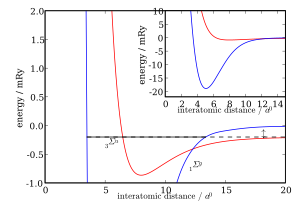Feshbach response
A Feshbach resonance is a phenomenon from the physical scattering theory that is named after the American physicist Herman Feshbach . It occurs when there is a bound state (molecular state) between two atoms in a scattering potential that is only slightly above the energy sum of the incoming particles. In this case the two atoms can adopt this bonded state. As a result, they “feel” the potential for a longer period of time and the change in their wave function increases. This changes the scattering length of the system.
Feshbach resonances can be brought about artificially: In the case of the magnetic Feshbach resonance, the Zeeman effect is used to shift the scatter potentials to one another in such a way that this resonance occurs. With the optical Feshbach resonance, on the other hand, the atoms are coupled with the state of the molecule by irradiating laser light with the exact energy distance. With both methods, the scattering length can be changed almost at will.
The molecular states are usually not actually occupied: This is impossible, since energy would be gained or lost in the process. Only when the energy of the molecular state coincides exactly with the energy sum of the incoming atoms does energy conservation apply and the atoms can form molecules. In the case of a magnetic Feshbach resonance, this case can be brought about artificially and, in this way, molecules can be specifically generated. You only need to adjust the magnetic field so that molecules form. Then you can lower the molecular potential, and the molecules remain.
Ultra cold atoms and molecules

The most important applications of the Feshbach resonance are likely to be in the area of ultracold atoms (10 −7 Kelvin and less). They are popular as a research object despite the experimental challenges, as they lead to heavy losses, especially with bosons , as the scattering length suddenly changes when tuning the magnetic fields, the atoms can thus collide and the atoms can be lost from the trap through collision processes.
This is exactly what is welcomed with fermions : The Feshbach resonance enables not only an interaction, but even one that can be changed as described above. For the first time, as mentioned above, it was therefore possible to use fermions to produce specific molecules. Since these in turn represent bosons as fermion pairs, they could be condensed in the form of a Bose-Einstein condensate (in specialist literature: BEC).
But not only that: if the molecular state is energetically higher than the energy sum of the incoming atoms (the interaction operator in the Hamiltonian must be negative), the interaction is attractive. If there is an attractive interaction between fermions, one of the requirements of the BCS theory is fulfilled. In this way, it was possible to create a BCS state from ultra-cold atoms, which is similar to the electron ground state of a superconductor . In this way, a so-called BEC-BCS transition is obtained through the Feshbach resonance, a currently (2007) very topical research area.
literature
- Herman Feshbach: Ann. Phys. (N. Y.) 5 , 357 (1958) doi : 10.1016 / 0003-4916 (58) 90007-1
- Ugo Fano : Nuovo Cimento 156 , 12 (1935)
- Ugo Fano: Phys. Rev. 124 , 1866 (1961) doi : 10.1103 / PhysRev.124.1866
- Per-Olov Löwdin : Studies in Perturbation Theory. IV. Solution of Eigenvalue Problem by Projection Operator Formalism . J. Math. Phys. 3 , 969-982 (1962) doi : 10.1063 / 1.1724312
- Claude Bloch : Nucl. Phys. 6 , 329 (1958) doi : 10.1016 / 0029-5582 (58) 90116-0
- Johannes H. Denschlag, Hanns-Christoph Nägerl , Rudolf Grimm: Molecules at absolute zero . In: Physics Journal . No. 3, 2004, p. 34.
